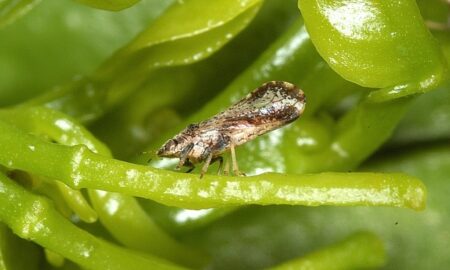Citrus Pathway Risk Assessment
Decision aid tool Monitoring tool
Asian citrus psyllid (David Hall, USDA Agricultural Research Service, Bugwood.org)
The Citrus Pathway Risk Assessment tool is designed to help biosecurity monitoring for the risk and likelihood of establishment for Asian Citrus Psyllid (ACP; Diaphorina citri Kuwayama). This pest is the most efficient carrier of Huanglongbing (HLB), a lethal disease of citrus also known as citrus greening or yellow dragon disease. To aid preparedness, this tool supports the robust national surveillance program for the early detection of exotic citrus pests.
Determining incursion pathways
Using publicly available data, the Citrus Pathway Risk Assessment tool models the risk of ACP entering Australia through six distinct pathways including commodity imports, locations of citrus plantations, and the latest demographic data from the 2021 census. These pathways are considered high-risk for incursion of ACP into Australia:
- Tourist pathway: Short-term visitors entering Australia for the purpose of tourism from countries where ACP is known to occur, representing a risk of inadvertently brining contaminated material upon their person.
- Visiting friends & family pathway: Short-term visitors entering Australia for the purpose of visiting friends and family from countries where ACP is known to occur, representing a risk of inadvertently bringing contaminated material as gifts.
- Returning resident pathway: Returning residents entering Australia from countries where ACP is known to occur.
- Sea cargo pathway: Sea cargo entering Australia through commercial ports and bringing in citrus commodities.
- Natural dispersal pathway: Windborne natural dispersal from Australia’s northern neighbours (Indonesia, Papua New Guinea, Timor-Leste), where ACP is known to occur.
- Budwood pathway: Illegally imported citrus budwood.
Scaling pathway risk
Each pathway ranges from 0 to 1 to represent relative risk of incursion through that pathway. Across each statistical area in Australia (SA2 as defined by the Australian census), a total incursion risk score is calculated as a weighted mean of the six pathways, with weights (representing greater or lower risk of each pathway) assigned through expert elicitation.
The Citrus Pathway Risk Assessment tool also calculates establishment likelihood (the chance that ACP will not only arrive but also establish long-term populations) using climatic suitability for ACP in Australia. It leverages publicly available global occurrence records of ACP to create a species distribution model (SDM) based on bioclimatic variables representing variation in temperature, precipitation, and primary productivity. This model is applied on the climatic layers of Australia to calculate a climatic suitability score for each area, ranging from 0 to 1. A total establishment likelihood score is then calculated based on incursion risk and climatic suitability.
How to use
In the app below, you can view the results of the model using two tabs.
Under the default Risk maps tab you can view the model as a fully interactive map, where each statistical area (SA2) is coloured based on relative incursion risk (by default). Hovering above each SA2 will show its name, and clicking on it will show a full run-down of its relative incursion risk, habitat suitability, establishment likelihood, and risk from individual pathways. The colour scale can be switched to either of these layers using the drop-down menu, and the slider on the left can used to filter the SA2s to only show ones which cross a user-defined threshold of the visualised layer.
Under the alternate Top risk tab you can view the results of the model in a tabular format, where outputs are ranked by decreasing order of the selected variable. You can filter results in a similar way to the map, and additionally filtering can be stratified by state – for example, only show the 0.9 quantile of incursion risk in each state. Buttons are available to download the displayed table (with filters applied) in either a .csv, .xlsx or .pdf format.
This web tool was developed by lead researcher Dr Alex Slavenko with support from Dr Roozbeh Valavi and Dr Luis Mata. Funding for this project Hort Innovation, using the citrus research and development levy and contributions from the Australian Government. Hort Innovation is the grower owned, not-for-profit research and development corporation for Australian horticulture. Other project partners are Plant Health Australia, Citrus Australia, and the Northern Territory Department of Industry Tourism and Trade.

Disclaimer:
The material included in the website is provided for general use and information purposes only. While reasonable care is taken in regards to the provision of material on this site, Cesar Australia accepts no responsibility for the accuracy, completeness or authenticity of any material contained in the site.
Cesar Australia recommends that users exercise their own skill and care with respect to the content of this website.
To cite:
Cesar Australia (2024) Citrus pathway risk assessment. https://cesaraustralia.com/resources/citrus-pathway-risk-assessment/
- Published
- Categories
- Integrated pest management
